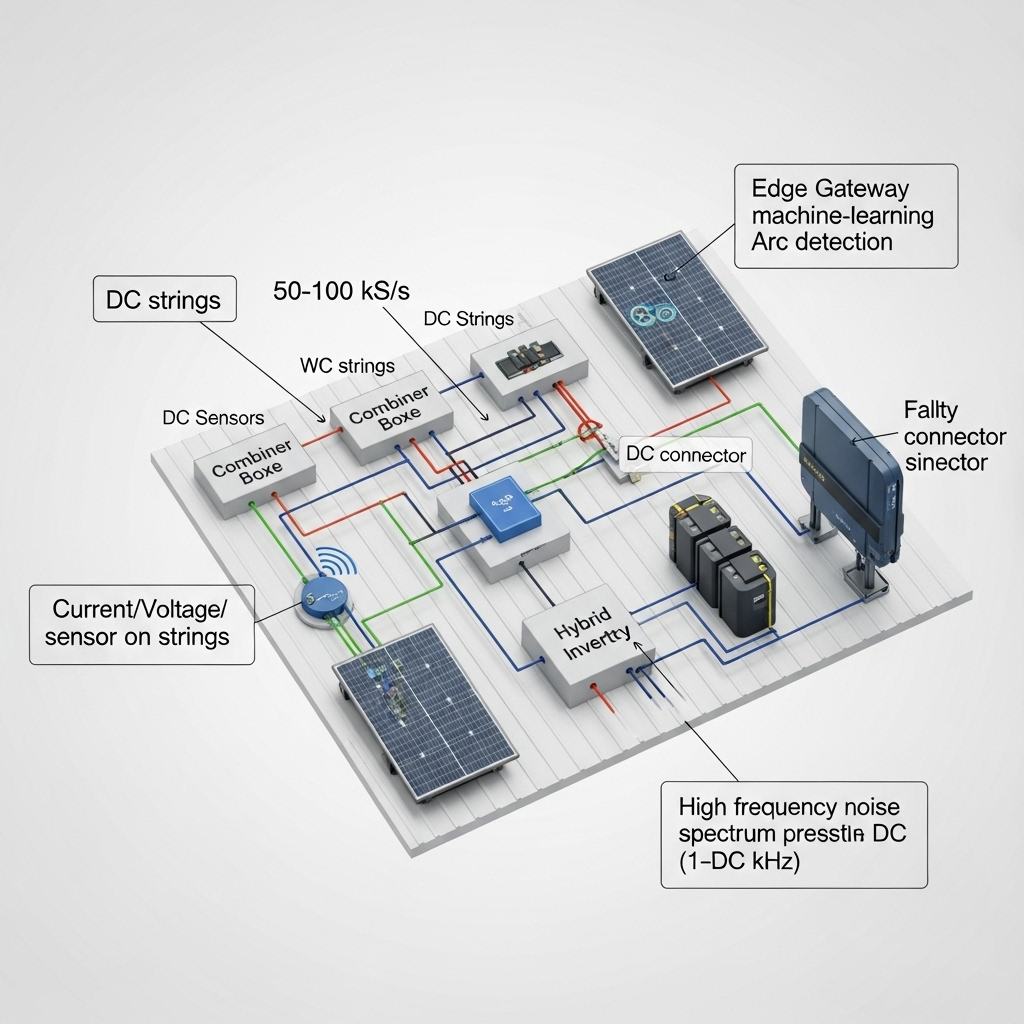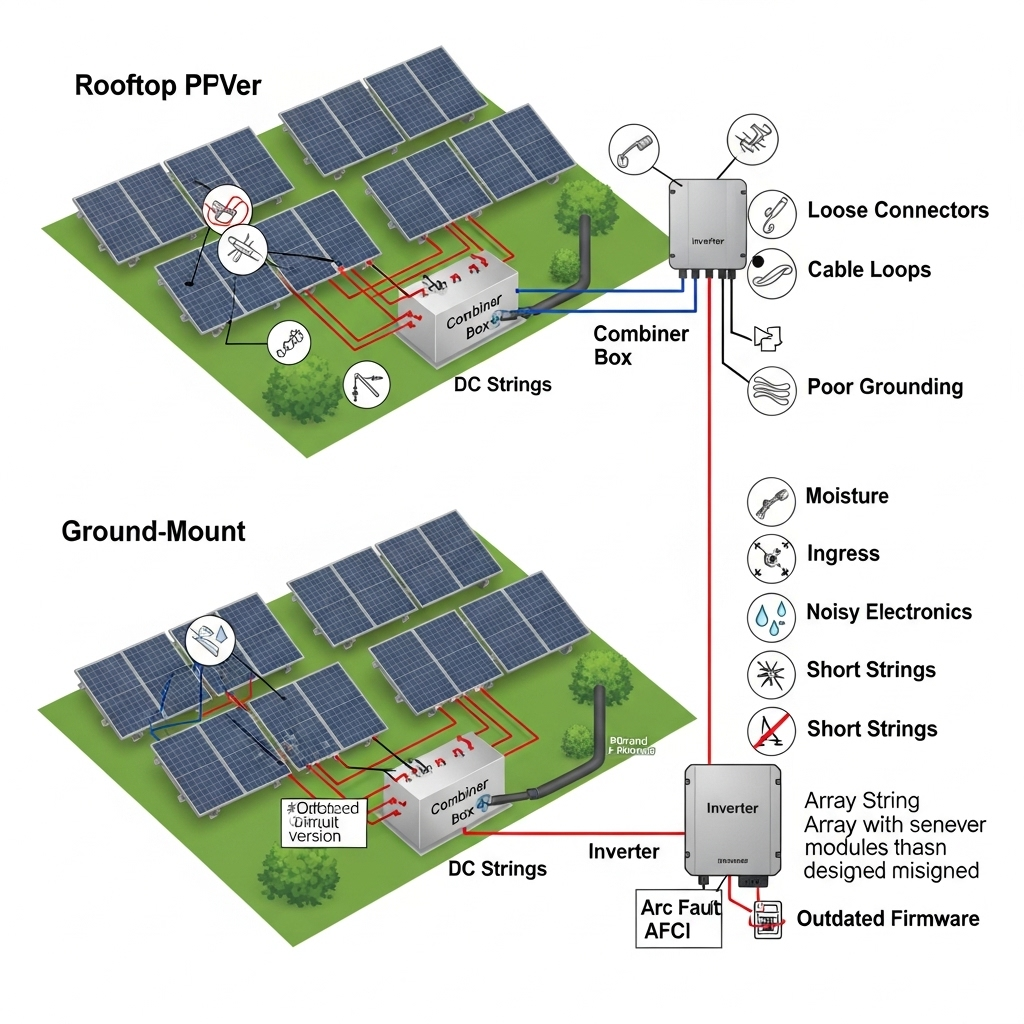Arc faults in rooftop PV can escalate from a faint hiss in a connector to a destructive DC arc. High-speed analytics changes the outcome. This case examines a large rooftop array where fast sensors, edge computing, and tuned algorithms cut risk, reduced nuisance trips, and mapped faults to a single string within seconds.
Why DC arcs appear on rooftop PV
Fault physics and signatures that analytics can see
Series arcs often start at high-resistance points: worn MC4 contacts, loose torque at terminals, UV-aged insulation, or water ingress. The signature is broadband noise superimposed on DC current and voltage, with energy concentrated in the 1–100 kHz band, intermittent amplitude bursts, and elevated kurtosis. Parallel arcs show larger DC sag and rapid heating. Switching noise from inverters can mask these features, so the model must learn to separate patterns under varying irradiance and MPPT behavior.
Safety baseline and codes
Modern rooftop PV above certain voltage and current thresholds must include arc-fault protection per regional rules (for example, NEC 690.11 in the United States). PV AFCI devices detect arcs and interrupt quickly. Guidance from energy.gov highlights fire prevention and safe PV operation, reinforcing the need for detection and rapid isolation. Field experience shows faster analytics improve location accuracy, which supports safer maintenance.
Case setup: a data-driven rooftop PV with storage
Site: five logistics rooftops, 1.28 MWp DC, 1,000 V strings, hybrid inverters tied to a lithium iron phosphate (LiFePO4) ESS. The storage smooths peaks and offers backup. The team builds LiFePO4 packs and integrated ESS, so control over inverter and battery telemetry enables synchronized analytics.
Sensing architecture
- DC current shunts per string (16-bit ADC, 100 kS/s at edge, anti-aliasing 200 kHz)
- DC bus voltage tap at inverter input (50 kS/s)
- HF electromagnetic probe near combiners for radiated noise
- Edge gateway: quad-core CPU, 2 GB RAM, real-time Linux, local model inference
- Time sync: PTP to align sensors and inverter events within 1 ms
Data strategy and labels
Historical nuisance-trip logs and thermal camera inspections built the initial label set. Controlled tests injected known loose-connector faults at low current and rising load, capturing onset signatures without damage. Weather station data supported context-aware thresholds.
Analytics: from raw waveforms to decisions
Feature engineering built for rooftop conditions
- Band-limited RMS: 15–60 kHz and 60–120 kHz windows to capture arc-dominated noise
- Spectral flatness and crest factor to separate arcs from inverter PWM harmonics
- Teager–Kaiser energy operator on current derivative for burst detection
- Wavelet packet entropy for intermittent arcs under passing clouds
- Voltage ripple asymmetry at the DC link during arc onset
Model, training, and thresholds
A gradient-boosted tree model runs at the edge with 200 ms windows, 50% overlap. The pipeline filters obvious non-arc events, classifies arc likelihood, then fuses evidence across sensors. Dynamic thresholds adapt to irradiance and temperature. A time-to-decision rule releases an alarm if the weighted likelihood stays high for 300–500 ms, balancing speed and false positives.
Real-time stack and SCADA
Data streams land in SCADA via MQTT. Alarms trigger automated actions: reduce inverter current, open string-level DC switch, and notify O&M. This connects to fault detection and diagnosis (FDD), performance ratio (PR) monitoring, and loss analysis workflows from the technical operations catalog, including real-time monitoring, weather impact assessment, health and safety management, fire detection and prevention, and technical reporting.
Results: faster detection, fewer nuisance trips
Within two months, the system caught a developing series arc at a rooftop combiner. Detection to isolation took 180 ms at 70% irradiance. Inspection found a degraded connector and heat discoloration. No panel damage.
| Metric | Baseline AFCI (legacy) | High-speed analytics AFCI |
|---|---|---|
| Sampling frequency | ~1–5 kS/s | 50–100 kS/s |
| Typical detection latency | 0.5–2.5 s | 0.15–0.5 s |
| Fault location granularity | Array/combiner | String-level |
| Monthly nuisance trips | 4–6 (windy/cloud-edge) | <1 |
| Yield loss from false trips | 0.3–0.6%/year | <0.1%/year |
The numbers above are site-specific and depend on equipment and thresholds. The direction matches published experience that digital control and visibility reduce operational risk across distributed energy resources. For broader cost context, Renewable Power Generation Costs in 2024 from IRENA reports continued declines in solar LCOE, so preserving uptime and limiting trips has a measurable impact on project economics.
Grid protection context with high inverter-based resources
High rooftop PV penetration changes fault behavior. Reduced fault currents and bidirectional flows challenge legacy protection logic. The IEA analysis on next-generation wind and solar notes that many PV inverters are grid-following devices with limited overcurrent capability. Protection settings need updates, and visibility from DERs becomes vital. Edge analytics helps by flagging faults early, at low currents, and informing dispatch.
AI and operations lessons
AI methods in energy are maturing. The IEA’s Energy and AI report highlights the role of ML for FDD and real-time decision support across O&M. In this project, simple, interpretable features plus boosted trees outperformed complex deep models under tight latency and limited training data. Explainable outputs (feature attributions) helped technicians trust alarms and speed up repairs.
Integration with LiFePO4 storage and hybrid inverters
Hybrid inverters and ESS add switching harmonics. The classifier must learn that pattern to avoid false positives. A practical tip: collect noise fingerprints of each inverter-ESS operating mode (charge, discharge, reactive support) and bake that into thresholds. For storage characteristics, the ultimate reference on solar storage performance summarizes typical LiFePO4 traits: high round-trip efficiency and long cycle life under moderate depth of discharge. Using a 10–90% SOC window keeps batteries in a stable region and limits thermal noise, which also stabilizes DC bus behavior during arc checks. Align inverter ramp rates so the classifier sees a steady baseline during checks.
Operations, compliance, and insurance
Arc analytics should land inside the same operational backbone as PR, loss analysis, and technical reporting. That keeps records consistent for audits and claims. Key touchpoints include:
- Grid Code Compliance and PPA compliance: feed alarm and repair timestamps to support availability metrics
- SCADA and cyber coverage: follow supervisory control policies and maintain audit trails
- Health, safety, and environmental workflows: integrate fire prevention playbooks and staff briefings
- Insurance management: property/equipment and business interruption policies often ask for evidence of preventive controls; analytics reports help with warranty claims
Policy and billing processes from commercial operation—revenue management, regulatory reporting, and investor reporting—benefit from clear availability data. For macro perspective on PV economics and operational value, see the IRENA cost study above and PV resources at EIA.
Non-legal note
This section shares technical practices for safety and compliance. It is not legal advice. Always consult local codes, AHJs, and certified electricians.
Practical design checklist
- Sampling: at least 50 kS/s on current, 25–50 kS/s on voltage; 16-bit resolution; anti-aliasing above 150 kHz
- Windows: 200–500 ms with 50% overlap for decisions under 0.5 s
- Features: combine spectral and time-domain features; monitor kurtosis and wavelet entropy for bursts
- Context: feed irradiance and inverter operating mode to adapt thresholds
- Actuation: support string-level isolation and staged derating to avoid full-plant trips
- Testing: staged loose-connector tests at low current; thermal camera verification
- Reporting: export alarms to SCADA, ticketing, and compliance logs
Cost and ROI framing
Downside protection matters most. Avoiding a single DC arc event can prevent module damage, roof repairs, and outage penalties. With LCOE trending lower per IRENA, protecting availability has a larger share of total value. High-speed analytics that cuts monthly nuisance trips from 4–6 to under 1 and trims detection latency below 0.5 s typically pays back through reduced truck rolls and preserved yield across the first season.
Technical appendix: sampling trade-offs
| Sampling rate | Latency target | CPU load (edge) | Recommended use |
|---|---|---|---|
| 10 kS/s | 1–2 s | Low | Legacy AFCI, limited HF detail |
| 50 kS/s | 0.3–0.7 s | Medium | Rooftop PV with reliable string isolation |
| 100 kS/s | 0.15–0.5 s | Medium–High | Detailed arc signature, better location confidence |
As noted in IEA’s inverter discussion, inverters continue to evolve. Coordination between inverter control loops and analytics avoids unnecessary trips and keeps headroom for real power response.
Takeaways
High-speed analytics improved arc detection on a complex rooftop PV with a hybrid inverter and LiFePO4 ESS. The stack delivered faster, more precise alarms, fewer trips, and cleaner reporting for SCADA, compliance, and insurance. The approach aligns with broad trends highlighted by energy.gov, IRENA, and the IEA on Energy and AI: better sensing, smarter software, and tight O&M integration reduce risk and raise performance.
FAQ
How fast should rooftop PV arc detection act?
Aim for sub-0.5 s from onset to isolation on rooftop strings. Faster action improves location accuracy and lowers thermal damage risk.
Does high-speed sampling increase false alarms?
Not if features and thresholds account for inverter switching and weather dynamics. In this case, false trips fell below one per month after tuning.
Can analytics locate the exact string?
Yes. Correlate high-frequency current noise across strings and DC-link ripple. The strongest signature plus voltage sag pinpoints the string.
How does storage affect detection?
Hybrid modes add harmonics. Record fingerprints per mode and adapt thresholds. Stable SOC windows keep the DC bus quieter, aiding detection.
What documentation supports claims and insurance?
SCADA alarms, waveforms, repair tickets, thermal images, and time-stamped reports. These align with insurance management and warranty claims processes.





Leave a comment
All comments are moderated before being published.
This site is protected by hCaptcha and the hCaptcha Privacy Policy and Terms of Service apply.